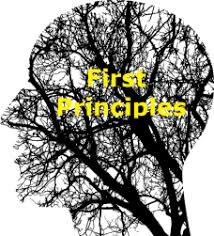
Recently I watched a documentary about Albert Einstein and his thought process. What struck me most about his genius was his ability to ultimately express complexity in simple equations. Specifically he was able to boil down his theory of relativity into one short equation….the first principle.
Elon Musk is also a fan of first principles. Like Aristotle, Euclid, Thomas Edison and Nikola Tesla; Elon has a method to his “thinking different” madness. It’s called First principles thinking and anyone can use it. Even the best pizza makers know to work from the center out…
What is first principles thinking?
First principles are the origins, main concepts or assumptions that cannot be deduced from anything else.
Thinking in terms of first principles is basically like starting your thinking or reasoning with the most essential facts.
Mindfulness is most elegant when described from the perspective of first principles. The beauty of mindfulness can be found in it’s ultimate simplicity. The recent explosion of popularity of mindfulness has been great for spreading the information but not so great in it’s dilution of understanding the first principles that make it work. I find it very important to keep these first principles close to me so that during stressful times I can remnd myself why I am practicing and how it works.
The first principle of mindfulness is embodiment. Research and experience tells us that many of us feel and are disconnected due to chronic stress. When we are chronically disconnected it results in a host of physical, mental and emotional problems and creates havoc throughout our nervous system. James Joyce in his classic book Dubliners says of one of the main characters, “Mr. Duffy lived a short distance from his body.” … Mr Duffy also suffered the results of chronic disconnection.
Mindfulness is designed to reverse that disconnection/disembodiment by focusing attention on the body, thoughts and emotions in every way possible. The first principle of embodiment ends up being expressed and practiced in the infinite possibilities of the bodily experience. Just like Einstein’s simple equation relating to the infinite, mindfulness’ simple process of embodiment relates to the infinite possibilities of human experience. When this embodiment/connection unfolds, it reveals to us our true nature of peace, love, kindness, compassion, universal connectedness and all the other qualities that we value.
When we get lost in the complexity of life and we begin to question our mindfulness practice it is always good to revisit the first principle of why we practice and how it works.
